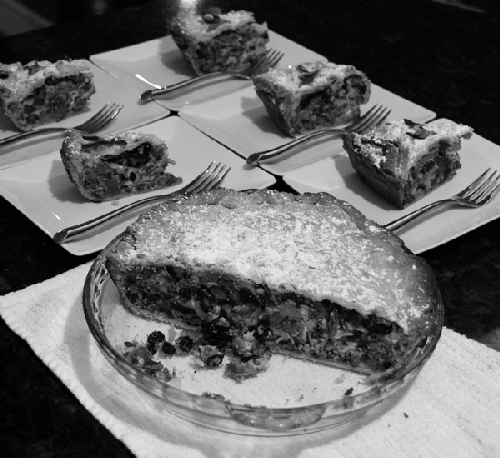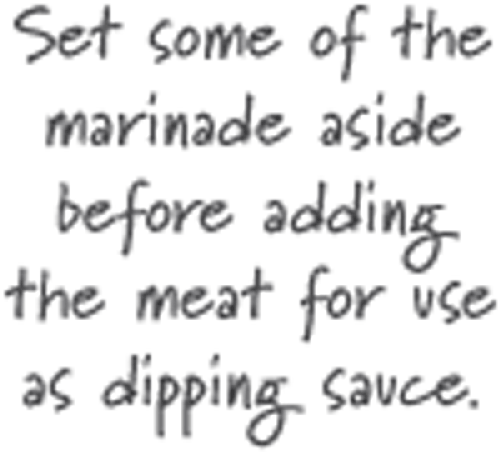Say
your Aunt Suzie sends you a jar of her famous (or is it infamous?) homemade quince jelly.
What to do with it? Someone suggests that you try it with Manchego cheese and crackers and,
sure enough, the combination is delicious. But why? One potential explanation can be found
in the history of the ingredients: they come from the same geographic region and its
corresponding cuisine.This method for thinking about flavor combinations is expressed in the idiom “if it
grows together, it goes together” and encompasses everything from a loose interpretation of
what the French call le goût de terroir (“taste of the earth”) to what
an American gourmand would term “regional cooking” for broad styles of cooking. In addition
to the limitation of ingredients based on what can be grown in any given area, regional
cooking also involves the culture and tradition of a region. Back to Aunt Suzie’s jelly:
Manchego cheese and quince jelly both have long histories in Spain, so the pairing is likely
rooted in history.
Given an ingredient, you can look at how that ingredient has been used historically in a
particular culture to find inspiration. (Think of it as historical crowdsourcing.) If
nothing else, limiting yourself to ingredients that would traditionally be used together can
help bring a certain uniformity to your dish, and serve as a fun challenge, too. And you can
extend this idea to wines to accompany your dishes, from the traditional (say, a French rosé
with Niçoise salad) to modern (Aussie Shiraz with barbeque).
The older the recipe, the harder it can be. One reason is
that language has changed. A lot. Take this example (also taken from Project Gutenberg) for
apple pie from The Forme of Cury, published around 1390 A.D.:
Tak gode Applys and gode Spycis and Figys and reysons and Perys and wan they
are wel brayed coloure wyth Safron wel and do yt in a cofyn and do yt forth to bake
well.
Almost as bad as a condensed tweet, this translates to: “Take good apples and good
spices and figs and raisins and pears and when they are well crushed, color well with
saffron and put in a coffin (pie pastry) and take it to bake.” (The “coffin”—little
basket—is an ancestor to modern-day pie pastry and would not have been edible at that point
in time.) Still, as a starting point for an experiment, the idea of making a mash of apples
and pears, some dried fruit, spices, and saffron suggests not just a recipe for pie filling,
but also a festive apple sauce for Thanksgiving.
Old recipes aren’t always so concise. Take Maistre Chiquart’s recipe for parma
torte in Du Fait de Cuisine, 1420 A.D. He starts with
“take 3 or 4 pigs, and if the affair should be larger than I can conceive, add another, and
from the pigs take off the heads and thighs, and...” He goes on for four pages, adding 300
pigeons and 200 chicks (“if the affair is at a time when you can’t find chicks, then 100
capons”); calling for both familiar spices like sage, parsley, and marjoram, and unfamiliar
ones such as hyssop and “grains of paradise”; and ending with instructions to place a pastry
version of the house coat of arms on top of the pie crust and decorate the top with a
“check-board pattern of gold leaf” (diamond-studded iPhone cases have
nothing on this guy).
Modernized version of parma torte, without the gold leaf, from
Du Fait de Cuisine, by Maistre Chiquart—France, 1420 A.D.

Needless to say, you’ll likely need to do some scaling and adaptation of older
recipes—again, part of the fun and experimentation! For parma tortes, I worked out my own
adaptation. I later found that Eleanor and Terence Scully’s Early French Cookery:
Sources, History, Original Recipes and Modern Adaptations (University of
Michigan Press) includes a nice adaptation.
Besides studying older recipes, you can look at traditional recipes from particular
regions to see how ingredients are normally combined. Different cultures have different
“flavor families,” ingredients that are thought of as having an affinity for one another.
Rosemary, garlic, and lemon are pleasing together—hence, traditional dishes like chicken
marinated in those ingredients. It can take time to build up a familiarity with flavor
families, but taking note of what ingredients show up together on menus, bottles of salad
dressings, or in seasoning packets is a good shortcut.
| |
Common ingredients
|
Served with...
|
|---|
|
Chinese
|
Bean sprouts, chilies, garlic, ginger, hoisin sauce, mushrooms, sesame oil,
soy, sugar
|
Rice
|
|
French
|
Butter, butter, and more butter, garlic, parsley, tarragon, wine
|
Bread
|
|
Greek
|
Garlic, lemon, oregano, parsley, pine nuts, yogurt
|
Orzo (pasta)
|
|
Indian
|
Cardamom seed, cayenne, coriander, cumin, ghee, ginger, mustard seed,
turmeric, yogurt
|
Rice or potatoes
|
|
Italian
|
Anchovies, balsamic vinegar, basil, citrus zest, fennel, garlic, lemon juice,
mint, oregano, red pepper flakes, rosemary
|
Risotto or pasta
|
|
Japanese
|
Ginger, mirin, mushrooms, scallions, soy
|
Rice
|
|
Latin American
|
Chilies, cilantro, citrus, cumin, ginger, lime, rum
|
Rice
|
|
Southeast Asian
|
Cayenne, coconut, fish sauce, kaffir lime leaves, lemon grass, lime, Thai
pepper
|
Rice or noodles
|
Common ingredients used in chicken dishes by a few common cuisines. (Note
that not all of these ingredients would be used simultaneously.)
The ingredients used to bring balance to a dish will vary by region. For example, the
Greeks use lemon juice in horta to moderate the bitterness of the dark
leafy greens like dandelion greens, mustard greens, and broccoli rabe, while the Italian
equivalent uses balsamic vinegar.

With even a short list of culturally specific ingredients as inspiration, you can create
simple marinades and dipping sauces without too much work. Pick a few ingredients, mix them
in a bowl, and toss in tofu or meat such as chicken tenderloins or steak. Allow the tofu or
meat to marinate in the fridge for anywhere from 30 minutes to a few hours, and then grill
away.
When creating your own marinade, if you’re not sure about the quantities, give it a
guess. This is a great way to build up that experiential memory of what works and what
doesn’t.
In a bowl, mix: ¼ cup (60g) yogurt 1 tablespoon (15g) lemon juice (about ½ lemon’s
worth) 1 teaspoon (2g) oregano ½ teaspoon (3g) salt Zest of 1 lemon, minced finely
|
In a bowl, mix: ¼ cup (70g) low-sodium soy sauce (regular soy sauce will
be too salty) 2 tablespoons (10g) minced ginger 3 tablespoons (20g) minced scallions (also known as green
onions), about 2 stalks 2 tablespoons (40g) honey
|
| |
Bitter
|
Salty
|
Sour
|
Sweet
|
Umami
|
Hot
|
|---|
|
Chinese
|
Chinese broccoli
Bitter melon
|
Soy sauce
Oyster sauce
|
Rice vinegar
Plum sauce (sweet and sour)
|
Plum sauce (sweet and sour)
Jujubes (small red dates)
Hoisin sauce
|
Dried mushrooms
Oyster sauce
|
Mustard
Szechwan peppers
Ginger root
|
|
French
|
Frisée
Radish
Endive
Olives
|
Olives
Capers
|
Red wine vinegar
Lemon juice
|
Sugar
|
Tomato
Mushrooms
|
Dijon mustard
Black, white, and green peppercorns
|
|
Greek
|
Dandelion greens
Mustard greens
Broccoli rabe
|
Feta cheese
|
Lemon
|
Honey
|
Tomato
|
Black pepper
Garlic
|
|
Indian
|
Asafetida
Fenugreek
Bitter melon
|
Kala namak (black salt, which is NaCl and Na2S)
|
Lemon
Lime
Amchur (ground dried green mangoes)
Tamarind
|
Sugar
Jaggery (unrefined palm sugar)
|
Tomato
|
Black pepper
Chilies, cayenne pepper
Black mustard seed
Garlic
Ginger
Cloves
|
|
Italian
|
Broccoli rabe
Olives
Artichoke
Radicchio
|
Prosciutto
Cheese (pecorino or parmigiano-reggiano)
Capers or anchovies (commonly packed in salt)
|
Balsamic vinegar
Lemon
|
Sugar
Caramelized veggies
Raisins / dried fruits
|
Tomato
Parmesan cheese
|
Garlic
Black pepper
Italian hot long chilies
Cherry peppers
|
|
Japanese
|
Tea
|
Soy sauce
Miso
Seaweed
|
Rice vinegar
|
Mirin
|
Shitake mushrooms
Miso
Dashi
|
Wasabi
Chiles
|
|
Latin American
|
Chocolate (unsweetened)
Beer
|
Cheeses
Olives
|
Tamarind
Lime
|
Sugar cane
|
Tomato
|
Jalapeño and other hot peppers
|
|
Southeast Asian
|
Dried tangerine peel
Pomelo (citrus fruit)
|
Fish sauce
Dried shrimp paste
|
Tamarind
Kaffir limes
|
Coconut milk
|
Fermented bean paste
|
Bird chili
Thai chili in sauces and pastes
|
Examples of ingredients used by different cultures to balance out flavors.
Use this chart as an inspiration to try out new combinations and take note of how the
various flavors change your perceptions.